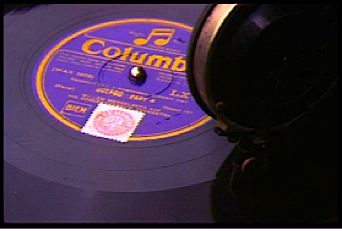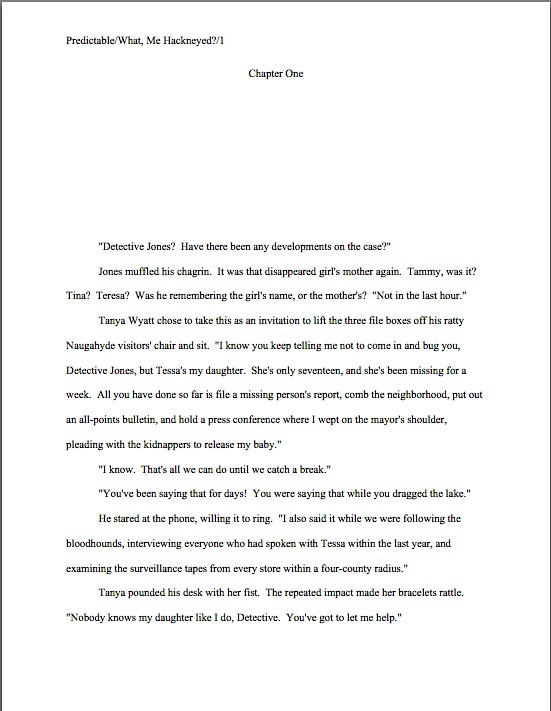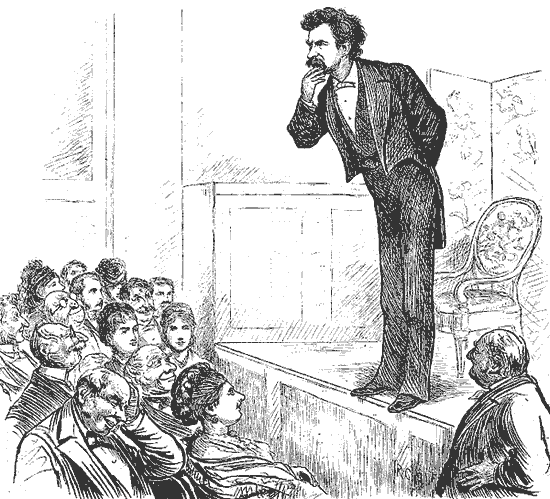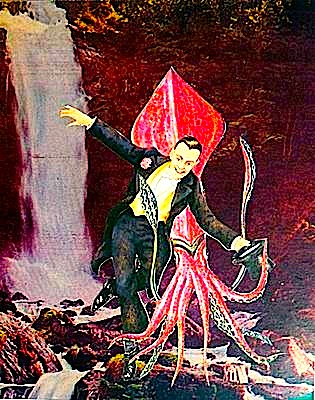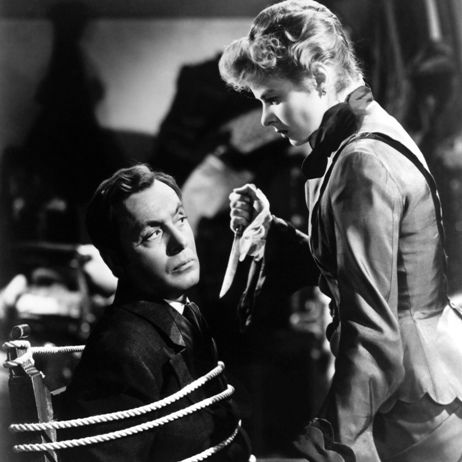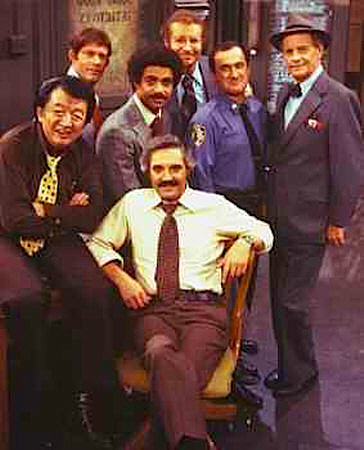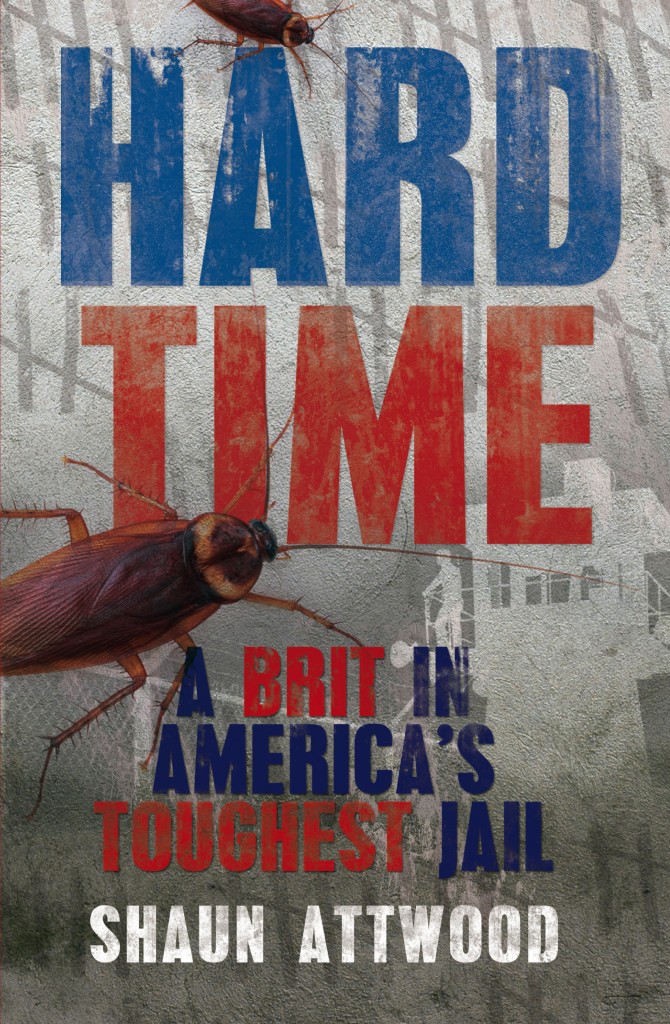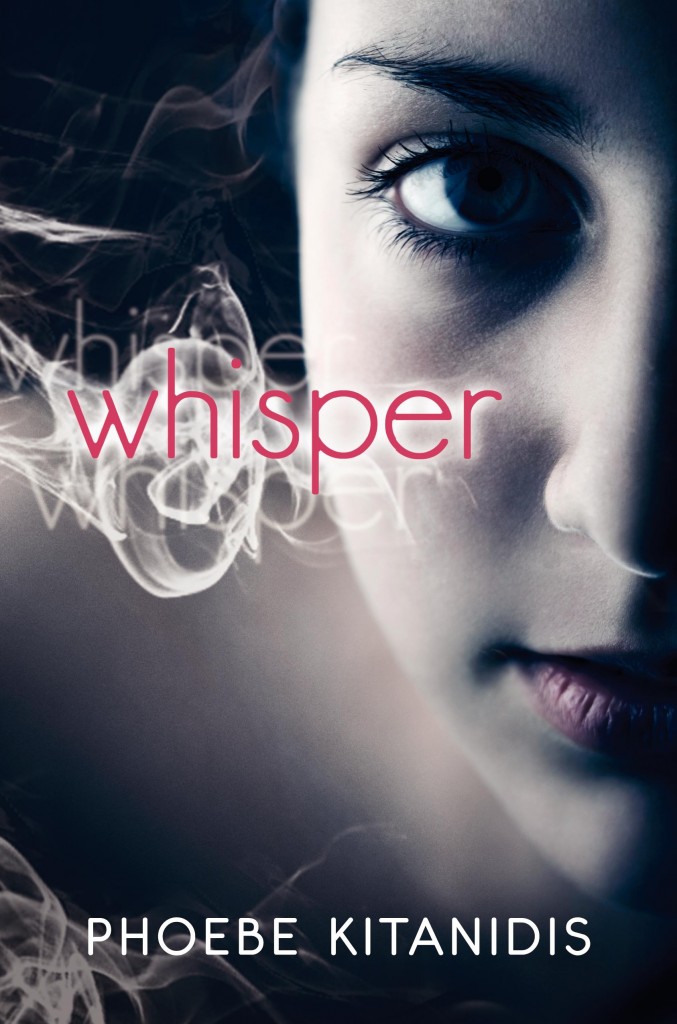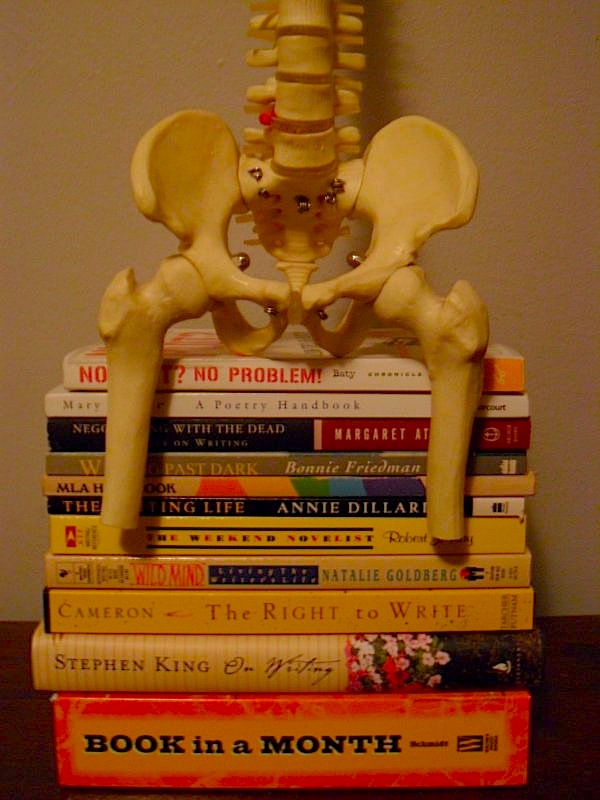
This, I am happy to say, used to be one of the views from my studio window, a sweet fir tree stuffed to the proverbial gills with cavorting crows, mischievous blue jays, and a small family of squirrels deeply devoted, for reasons best known to themselves, to digging up my crocus bulbs, saving them for a month or two, then replanting them in entirely different locations. I used to enjoy watching them before the strange men from the phone company showed up unannounced yesterday and slashed a ten-foot hole in the middle of the tree in order to make room for a half-inch cable scheduled to be installed three months from now. As one does.
Actually, it would have been a twenty-foot hole — quoth the foreman: “But those other branches were, like, in our way! We would have had to work around them!” — had I not managed to hobble out front to stop them in mid-slice. (Never underestimate the moral force of a crutch-wielding Valkyrie with a rudimentary knowledge of property law.) The damage has been done, though: this morning, there are no birds in the defiled tree.
Why does this seem like an apt time to wrap up this series on revising dialogue?
I can tell you why: all too often, in the first glow of enthusiasm following a newly-acquired self-editing tip — or, if you’ve been following our intensive discussions of craft this summer, a whole mess of ‘em — writers will, to put it succinctly, over-cut. Fired up by the time-honored advice to kill their darlings, they hack and slash with gusto, assuming, sometimes incorrectly, that if a line or two of dialogue runs afoul of the freshly-learned rule, the entire speech should go. Or the entire scene. Or the entire chapter.
But not all darlings are apt candidates for slaughter. Sometimes, too-vigorous cutting can do some serious harm to the tree. You don’t want to scare off the pretty birds, after all.
(I know — isn’t it amazing how often my day-to-day life provides PRECISELY the metaphor for what we’ve been discussing? Somebody up there must have a great fondness for blogs. Either that, or a monumental antipathy toward trees.)
Which is to say: not all of the results of revision are necessarily intentional. Over-enthusiastic cutting can, among other things, result in uneven tone, the loss of information the reader might need to know later in the plot, confusion of motivation, the omission of that foreshadowing sneer that alerts the attentive reader to the possibility that the protagonist’s mild-mannered coworker may turn out to be the super villain intent on destroying every ice cream stand in Gotham…
It can lead, in short, to a Frankenstein manuscript. There is no such thing, then, as a revision that would not benefit from a follow-up re-reading of the ENTIRE manuscript (preferably IN HARD COPY and, especially if it is dialogue-heavy, OUT LOUD) to make absolutely certain that the post-cut scenes not only read well on the page, but still pull their weight in the plot.
With that incentive for caution in mind, here is a final post in our revisit to 2009’s Seeing Submissions From the Other Side of the Desk series. Actually, it’s a mash-up of two posts in that series, presented in composite form for your perusing pleasure. When I originally posted the second, John Updike had just died — providing, yet again, a nudge toward a blog-friendly example.
Enjoy! But please, employ your pruning shears judiciously — and sparingly — after reading it.
Are you surprised to see another post on first-page rejection reasons coming after I’ve already gone over the agent-generated list of submission red flags? What can I possibly still have to say on the subject, after nearly three weeks of harping upon it?
Plenty, as it turns out. As excellent and extensive as the agent-generated list was in its day, as full of classic submission problems as any such list could possibly be, the agents in question generated it several years ago. As I’ve been shouting from the rooftops practically since I began writing this blog, the standards for what agents are seeking in a manuscript change all the time, along with the literary market itself.
Contrary to popular belief amongst aspiring writers, good writing, a solid premise, and catchy character names are not necessarily enough to catch an agent’s eye today. Yes, a novel or memoir submission typically needs all of those elements to be successful, but now as ever, it needs something else: to be a book that the agent can picture selling in within not an ideal market, but the one in which s/he is currently attempting to sell books.
Yes, I do realize what I just said: a manuscript could conceivably be perfectly marvelous and still not be what an agent would consider marketable in the literary market right now.
Why right now in particular? Well, agents have always made their living by selling their clients’ work to publishers — since reputable agents don’t charge fees over and above their contracted percentage of a book sale, they make money only when they hawk their clients’ books successfully — but even a cursory glance at PUBLISHERS WEEKLY or PUBLISHERS MARKETPLACE will tell you that these are exceptional times for the publishing industry.
What does this mean for aspiring writers? Probably, that agents will be a bit warier about picking up new clients until the publishing houses decide what their new strategies will be. That, and that vampire books like the TWILIGHT series will continue to get snapped up at a prodigious rate until the next surprise bestseller comes along. {Present-day Anne here: amazingly, although I originally posted this a year and a half ago, this statement remains true. That’s how cautious agents have become.}
So the best thing you could possibly do right now is rush right out and buy 50 books similar to yours — and convince 100,000 of your friends to do the same. Like it or not, that’s now new marketing trends are made.
Since my readership is made up almost exclusively of writers, I’m going to go out on a limb here and assume that none of you like it.
I don’t pretend to be able to predict the next big thing — other than the novel I’m about to finish writing, of course — but there are a few trends in what gets rejected and accepted that I’ve noticed cropping with increasing frequency over the last year or so. Since once a pet peeve is established, it tends to hang around for a while on Millicent the agency screener’s red flag list, it’s probably a good idea to avoid them for the foreseeable future.
I know — kind of ironic, given how opaque the future of publishing is right now. Let’s plow ahead anyway. Some stuff that hasn’t been playing well lately {and, again, this list remains astonishingly current}:
1. Unprofessionally formatted manuscripts.
I know that I harp on this one quite a bit — as evidence and for the benefit of readers new enough to this blog not to have lived through my extensive discussions of what publishing professionals expect manuscripts to look like, please see the HOW TO FORMAT A MANUSCRIPT and STANDARD FORMAT ILLUSTRATED categories on the archive list at right — but it honestly is true that if a submission does not look professional, Millicent is more likely to reject it, regardless of the quality of the writing. Since the volume of queries and submissions has been skyrocketing as the economy has worsened (writing a book is a LOT of people’s Plan B, apparently), she can afford to be even pickier than usual.
Take the time to make it look right.
2. “I’ve seen that before.”
This is a practically inevitable side effect of the aforementioned volume of queries and submissions rising, but standard storylines, stock characters, and literary clichés in general seem to be getting judged more harshly of late, probably because Millicent has been seeing the same things over and over again.
Does this mean that this is a great time for writers who embrace radical originality. Not exactly, because…
3. Fiction that challenges the status quo very strongly.
This is one of the truisms of the publishing industry for the last century — during uncertain economic times, comforting and escapist plot lines tend to sell better. Unfortunate, but true. It has to do with what’s known as the Peanut Butter and Jelly Index: when Americans are feeling insecure about the future, sales of inexpensive comfort foods tend to rise — as do books that make readers all warm and fuzzy.
Historically, agents and editors have followed these trends, shying away from more challenging plot lines, unusual worldviews, and even experimental use of prose. Since I’m personally a big fan of challenging plot lines, unusual worldviews, and experimental use of prose, I’m not all too happy about this, but it might be worth holding off on submitting any of the above for a few months, until the industry has had time to get used to new economic realities.
I know; it’s annoying. {Even more annoying: that this advice is still apt, to a very great extent.}
4. Vocabulary or tone inappropriate to book category.
I’ve been hearing a LOT of complaints in that bar that’s never more than a 100 yards from any literary conference in North America about submissions from writers who don’t seem aware of either the target audience or the conventions of the categories in which they have written books. From coast to coast, Millicents and their bosses have been railing about YA with too-adult word choices, literary fiction with a fourth-grade vocabulary, cynical romances, paranormals where vampires cavort in the sun…
I suspect that the increased pervasiveness of this one is actually an expression of the publishing industry’s smoldering resentment that book sales have dropped; if the writers of these books were actually buying the new releases in their genres, the logic goes, they would be more conversant with what’s selling right now. Having met scads of writers who say, “What do you mean, what do I read? I don’t have time; I’m too busy writing,” I have to say, I have some sympathy with this one.
Remember, from the pros’ point of view, a writer’s being up on the current releases for her type of book is considered a minimum standard of professionalism, not an optional extra. At least take the time to go to a well-stocked bookstore and thumb through the recent releases, to make sure that your submission doesn’t fly too far out of the acceptable range.
5. Narrative voices that read as though the author has swallowed a dictionary.
This is a perennial complaint that’s been getting more play recently, probably because of the convenience of the Thesaurus function in Word, but for Millicent, a submission crammed with what used to be called three-dollar words does not necessarily read as more literate than one that relies upon simpler ones. Especially if — and this problem turns up more often than anyone would like to admit — not all of those words are used correctly.
Or, to put it as some aspiring writers might: without embroiling us in superfluous polysemousness, it must be averred that the aesthetic propensities of a vainglorious tome toward prolixity or indeed even the pseudo-pragmatic co-optation — as by droit du seigneur — of an antiquitarian lexis, whilst purportedly an amendment to the erudition of said opuscule and arguably consanguinean (metaphorically speaking) and perhaps even existentially bound up with its literary apprizal, can all too facilely directionize in the azimuth of fustian grandiloquence or unmanacle unpurposed (or even dystelelogical) consequences on a pith and/or douceur de vivre level vis-à-vis even the most pansophic reader. As Pliny was wont to quip in his cups…
Come on, admit it: this is a BIT over-the-top for YA.
Yes, yes, I know that English is a beautiful language crammed to the gills with fabulous words, but use that thesaurus sparingly: from a professional reader’s point of view, the line between erudite and pretentious can sometimes be pretty thin. Few readers, they argue, will actually stop reading in order to go and look up a word in a novel written in their native tongue.
They speak from personal experience: it’s something Millicent would literally never do while scanning the first few pages of a submission.
Here again, your best guideline is the current market for your type of book: generally speaking, a writer will always be safe sticking to the vocabulary level of recent releases in his book category. If you want to sneak in more obscure words here and there, make sure that their meaning is evident from context. Trust me on this one.
6. Humor that Millicent doesn’t find funny.
Perhaps it’s due to the major presidential candidates’ having employed speechwriters last time around who wrote better jokes for them, but in the last few years, more aspiring writers seem to be trying to incorporate humor into their work. Since genuinely funny writing is a rare and wonderful thing, I can only applaud this trend.
Just make sure that it’s actually funny before you submit it on the page — not just to you and your kith and kin, but to someone who has never met you and is from a completely different background. And no, having one character laugh at a joke another character has just made will not cause Millicent to find it humorous.
Remember, too: nothing dates a manuscript faster than borrowing a joke from the zeitgeist. Particularly if the joke in question is lifted from a sitcom. (Have your parents explain why they ever thought “Whatchoo talkin’ about, Willis?” was funny, children.)
If you choose to open with humor, run your first scene (at least) by a few good, unbiased first readers before submitting it. Even those of us who write comedy professionally are heavily reliant on reader reaction to determine what is and is not legitimately funny.
7. Unlikable protagonists.
This is another golden oldie that’s been cropping up with increasing frequency of late: it’s long been an industry truism that if the reader doesn’t find the protagonist likable, she’s not going to want to follow him through an entire book. And I don’t just mean finding him kind of tolerable; Millicent’s going to want to find the guy actively engaging.
Why might this perennial objection be flying out of Millicent’s mouth more often recently, you ask? Did you read that one above about the Peanut Butter and Jelly Index?
And don’t tell me that your protagonist or narrator becomes more likable as the reader gets to know her. If the writing on page 1 doesn’t grab Millie, it doesn’t matter if the protagonist is marvelous on page 15.
It’s not as though agents or editors open books at random to check out the writing, after all. Millicent honestly does expect to see your best writing on page 1 of your submission — and that since she is going to assume that the writing on page 1 IS your best writing, it’s worth taking exceptional pains over it.
Begin at the beginning, as a reader would, when you revise. Your time investment will bear the greatest returns there. As agents have been known to tell one another when they’re in their Pliny-like cups (in that bar that’s never more than 100 yards from any writers’ conference, natch), they want to fall in love on page 1.
All that being said, a moment of silence, please: John Updike is dead.
When I heard the news — repeatedly; one of the mixed blessings of being widely known as a writer and descendent of a long line of writers is that people very considerately call to break the news to me whenever any well-established author kicks the bucket, as if everyone who has ever set pen to paper were a distant cousin of mine whose death I should not be forced to learn from the standard media sources — I naturally went straight to my bookshelf and glanced through some of his work. In light of our ongoing series on opening pages and the fact that his first novel, THE POORHOUSE FAIR, came out in 1959, I expected his initial pages would, to put it politely, have a tough time making in past today’s Millicents, thus underscoring Updike’s frequently-made point about how literary fiction has been all but brought to earth over the last 40 years.
I was pleased to find that quite the opposite was true: his first pages were grabbers. Take that, eulogists of literary fiction!
More to the point of the latter part of this series, his hooks largely operated not through garish action, but interesting character development. Take a gander, for instance, at the first two paragraphs of THE WITCHES OF EASTWICK (1984):
“And oh yes,” Jane Smart said in her hasty yet purposeful way; each s seemed the black tip of a just-extinguished match held in playful hurt, as children do, against the skin. “Sukie said a man has bought the Lenox mansion.”
“A man?” Alexandra Spofford asked, feeling off-center, her peaceful aura that morning splayed by the assertive word.
Now, we could speculate all day about the probable insecurities of a male author who felt compelled not only to have a female character repeat the word man here, as though the very concept of the Y chromosome were inherently unsettling to heterosexual women (at least the frail kind discombobulated by assertive words) but also to employ splayed, a term commonly associated with the things models do in the centerfolds of men’s magazines, to describe a mental state. It might not be too much of a stretch to assume based upon this opening that Mr. Updike wasn’t picturing much of a female readership for this book when he wrote it — intriguing, since in 1984 as now, women were far and away the most common purchasers of literary fiction.
But none of that concerns us at the moment. Look, I ask you, at how beautifully he has used visceral details to establish both a mood and character in the first lines of this book.
It’s a heck of an opening in general. Let’s take a moment to ponder why: instead of easing the reader into the story by an extensive description of the physical space in which we discover these characters, or the even more common physical description of the characters themselves, Updike introduces these women by providing specific insight into their mental processes and motivations. Instead of just telling us that Jane is mean and Alexandra shy, he shows us through an analogy and word choices that we might not expect.
Yes, what you just thought is absolutely right: this opening would grab Millicent because it’s not only well-written, but surprising.
Seeing all the elements in action helps to clarify what we’ve been talking about, doesn’t it? But while we’re at it, let’s be thorough about this. Quick, without rushing back and checking our initial list of red flags that often lead Millicent to reject a submission on page 1, what might strike her as problematic if she saw this opening in a submission by a brand-new writer today?
If you pointed out the typo in the very first sentence, give yourself a great big gold star for the day. (Technically, there should be a comma between oh and yes; as Mr. Updike was a graduate of my alma mater, I’m relatively certain that he should have been aware of this.) While some Millicents might be kind enough to read past a first sentence grammatical or spelling error, it’s not a foregone conclusion.
Proofread.
While we’re giving out prizes for observation, take a red ribbon out of petty cash if you flagged the repetitive dialogue. As we discussed earlier in this series, repetitive dialogue tends to annoy agents and editors, since they’ve been trained since they were pups to excise redundancy. Besides, characters who simply echo what has already been said tend to come across as less intelligent than those who actually add something new to the conversations in which they participate — always a tad risky in a protagonist.
Anything else? What about the unnecessary tag lines (Jane Smart said, Alexandra Spofford asked), now out of fashion? Since Mr. Updike had already been established in the first rank of North American authors by the time for decades by the time the use of tag lines fell out of fashion, this might seem like an unwarranted quibble, but remember, we’re judging this by the standards that would apply to a writer trying to break into the biz now.
Long-time readers, pull out your hymnals and sing along with me now: an established author can often get away with things that someone new could not.
Did any of you red-flag the semicolon? If Mr. Updike were submitting this to Millicent labeled as anything but literary fiction, you’d be right to consider cutting it. Generally speaking, in fiction that isn’t aimed at a college-educated audience — as literary fiction is, ostensibly, but most fiction is not — semicolons are considered a bit highbrow.
Admittedly, the fact that Millicent regularly sees manuscripts whose vocabulary barely scrapes the 10th grade positively peppered with semicolons might have something to do with this. No one but writers really like semicolons, and not even all of us use them correctly (as the late John Harvard would no doubt be delighted to note, Mr. Updike has done properly above), but my, don’t we like to shoehorn them into a manuscript!
Unless you’re submitting your work as literary fiction to an agent with a successful track record of representing a whole lot of it AND her client list fairly bristles with semicolon-wielding authors, you might want to minimize their use.
All of which, as fate would have it, is a perfect lead-in to my wrap-up of the rejection reasons because, really, it’s important to recognize that while, in the past, agents tended to be open to working with their clients in order to work out the technical kinks prior to submission to publishing houses, now most of them expect writers to submit manuscripts so clean and camera-ready that the agency screener could confidently walk them directly from the agency’s mail room to the desk of even the pickiest editor. Thus these last few weeks of weeding out the most common submission problems, at least on page 1: we’ve been going over these points exhaustively precisely so you can meet standards far higher than when the late, great Mr. Updike faced when he was first trying to break into the biz.
Today, however, we get to see the reward: the kind of manuscript that makes agents weak in the knees.
Surprisingly, agents and editors tend not to talk too much at conferences about what they love to see in manuscripts. They tend to stick to describing what is marketable, because that is, after all, their bread and butter. Remember, agents (most of them, anyway) don’t hold submissions to such high standards in order to be mean — they want to take on books that they know they can sell within today’s extremely tight market.
Which is to say: it’s not enough for an agent to love your work; she needs to be able to place it at a publishing house for you. Contrary to popular opinion amongst aspiring writers, that’s in the writer’s interest as much as the agent’s.
But as those of you who have been querying strong, marketable projects for a while already know, agencies often reject submissions for perfectly marketable books, a fact that is very confusing to those who believe that every agent is looking for the same thing, or that a single rejection from a single agent means that everyone in the industry will hate a book. Or that there exists writing so beautifully literary that every agent currently drawing breath will instantly exclaim, “Oh, of course — I’ll represent that!”
Especially for first fiction or memoir, it’s not enough for an agent to recognize that a writer has talent and a book has market potential: they like to fall in love. If you’re a good pitcher, you already know the reaction I’m talking about: the eyes becoming moist with desire, the mouth appearing to go dry with lust. When an agent wants a project, the symptoms strongly resemble infatuation, and as this series has taught us, it’s often a case of love at first sight.
As with any other type of love, every agent has his own particular type that is likely to make his heart beat harder, his own individual quirks and kinks. Just as an agent will train his screeners to rule out submissions containing his pet peeves, he will usually set some standards for the kind of project he would like to see forwarded to his desk.
So, in a way, our old pal the underpaid, latte-quaffing, late-for-her-lunch-date screener is her boss’ dating service. Literarily, of course.
With an eye toward getting your submission on the litero-romantic short list, here’s the list of what the Idol panelists said would light their fires sufficiently to ask for a second date. In other words, these are the traits they said would lead them to want to read beyond page 1 of a submission:
1. A non-average character in a situation you wouldn’t expect.
2. An action scene that felt like it was happening in real time.
3. The author made the point, then moved on.
4. The scene was emotionally engaging.
5. The narrative voice is strong and easy to relate to.
6. The suspense seemed inherent to the story, not just how it was told.
7. “Good opening line.”
8. ”There was something going on beyond just the surface action.”
Notice anything about this list? Like, say, that the opening of THE WITCHES OF EASTWICK knocks every single one of these criteria out of the proverbial ballpark?
Hey, I told you Updike’s work stood up well.
Notice anything else? How about that all of these criteria could be applied equally well to a memoir and a novel? That’s something that memoirists often forget: just because a story is true does not mean that it will be judged by less stringent requirements than a fictional one. A good memoirist, like a good novelist, is first and foremost a storyteller.
“Hey,” I hear some of you out there saying, “isn’t there something missing from this list? Shouldn’t ‘This is a marvelous writer,’ or ‘That’s the best metaphor I’ve ever seen for a love affair gone wrong,’ or ‘Wow, great hook’ have made the list? Shouldn’t, in fact, more of these have been about the craft of writing, rather than about the premise?”
Excellent questions, both. Would you like the cynical answer, or the one designed to be encouraging to submitters?
Let me get the cynicism out of the way first: they are looking for a book that can sell quickly, not necessarily a writer whose talent they want to develop over a lifetime, and that means paying closer attention to an exciting plot than pure beauty of voice. Yes, they are seeking good writing with a genre-appropriate voice, but at first glance, they are looking to fall in love with a premise.
The less cynical, and probably more often true, reason is that this is not the JV team you are auditioning to join: this is the big league, where it is simply assumed that a writer is going to be talented AND technically proficient AND able to draw the reader immediately into a pulse-elevating plot.
Unless an agent specifically represents literary fiction — not just good writing, mind you, which can be produced in any book category, but that specific 3-4% of the fiction market which is devoted to novels where the loveliness and/or experimental nature of the writing is the primary point of the book — the first question she is going to ask her screener is probably not going to be, “Is it well-written?”
Why not? Well, presumably, if any submission weren’t fairly well-written and free of technical errors, it would not make it past the screener. Thus, her question is much, much more likely to be, “What is this book about?”
Before you sniff at this, think about it for a minute: the last time you recommended a book to someone, did you just say, “Oh, this is a beautifully-written book,” or did you give some description of either the protagonist or the plot in your recommendation? Even the most literary of literary fiction is, after all, ABOUT SOMETHING.
Ideally, any good novel will be about an interesting character in an interesting situation. Why does the protagonist need to be interesting? So the reader will want to follow her throughout the story to come, feeling emotionally engaged in the outcome. Why does the situation need to be interesting? So the reader will not figure out the entire book’s plotline on page 1.
If you have included both of these elements in your premise, and you have presented them in a way that avoids the 74 rejection reasons I’ve been discussing throughout this series, most of the rest of the criteria on this love-it list will follow naturally. Not necessarily, but usually.
If the reader cares about the protagonist, the stakes are high enough, and the pacing is tight, the scene is much more likely to be emotionally engaging than if any of these things are not true. If you eschew heavy-handed description and move straight to (and through) the action, conflict is more likely to seem as though it is happening in real time, no one can complain that you are belaboring a point, and the suspense will develop naturally.
So really, this avalanche of critique has been leading directly to the characteristics of an infatuation-worthy book. (You’re welcome.)
Of course, all of this IS about the quality of the writing, inherently: in order to pull this off successfully, the writer has to use a well-rehearsed bag of tricks awfully well. Selecting the right narrative voice for a story, too, is indicative of writerly acumen, as is a stunning opening line. Each of these elements is only enhanced by a beautiful writing style.
However, most agents will tell you that lovely writing is not enough in the current market: the other elements need to be there as well. As well as a certain je ne sais quoi that the pros call an individual voice.
All of which is to say: submission is not the time to be bringing anything but your A game; there really is no such thing as just good enough for a first book in the current market. (Unless, of course, you’re already established, like John Updike, or a celebrity, or you happen to have written the story that the agent always wanted to write himself, or…) Playing in the big leagues requires more than merely telling a story well — that’s the absolute minimum for getting a serious read.
Which brings me to #8, ”There was something going on beyond just the surface action.” Submission mail bags positively burgeon with clear accounts of straightforward stories, as well as with manuscripts where every nuance of the plot is instantly accessible to the reader as soon as it is mentioned. Books that work on a number of different levels simultaneously, that give the reader occasion to think about the world to which the book is introducing her, are rare.
That the Idol agents would be looking actively for such a book might at first blush seem astonishing. How much subtlety could a screener possibly pick up in a 30-second read of the first page of a manuscript?
Well, let me ask you: the last time you fell in love, how much did you feel you learned in the first thirty seconds of realizing it?
On that note, I’m going to close this series. Pat yourselves on the back for making it all the way through this extremely sobering list, everybody: this was good, hard, professional work, the kind that adds tangible skills to your writer’s tool bag. Be pleased about that — and keep up the good work!





